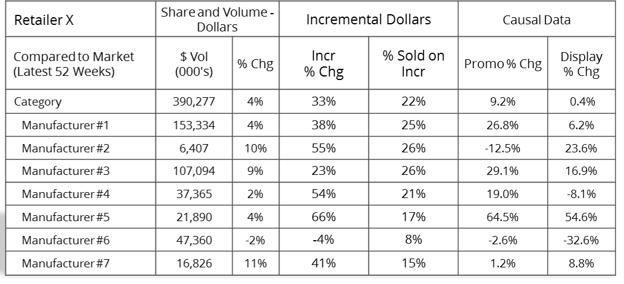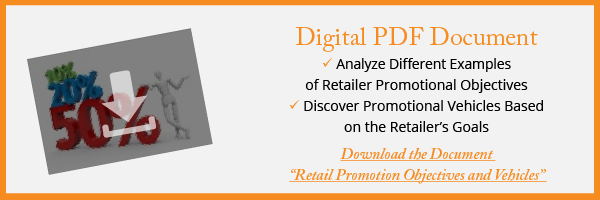Progressive Grocer recently ran an article on “How Ineffective Promotions Are Dragging Down Top Consumer Packaged Goods Brands”.
According to this article, the top 100 consumer packaged goods brands saw sales and market slip significantly over the past year, losing significant market share to smaller brands and store brands. Inefficient trade promotion is cited as the key reason for this loss.
Another core reason is that many companies fall short of their potential because they attempt to deploy advanced promotions without having a solid understanding of the basics.
Historically, Retailers have relied on Manufacturers’ marketing plans to drive consumers, in search of national brands, into the store. Retailer’s focus has changed over the past decade, including more emphasis on their own private label brands, and use of their retail stores as marketing media tools. The shift is a result of Shopper marketing.
The roles and approaches of the Retailer and Manufacturer need to also change because of:
- changes in traditional media and consumers,
- the strength of private label brands, and
- the Retailer’s unique Shoppers.
Change can only begin with a solid understanding of the basics of promotion – including strategies and analytics for both Retailers and Manufacturers.
Here are some resources to help you improve your promotion effectiveness:
- Download: Retail Promotion Objectives and Vehicles
- Video Preview: Promotion Analysis Techniques
- Course Overview & Purchase: Promotion Analysis Techniques
3 Steps: Promotion Basics
1. Confirm Promotion Objectives and Strategies
Why promote? Retailer objectives may include:
- Drawing new customers or traffic into the retail stores – or acquiring new customers.
- Bringing loyal customers back to the retail stores more frequently – or retaining their most loyal customers.
- Influencing shoppers to purchase once they are in the store – or selling more to shoppers.
Each of these objectives should use different Promotion vehicles to communicate with consumers or shoppers. Retailer’s promotions at a category level must relate to the roles and strategies assigned to each category, including consideration for promotion pricing strategies.
Vendors promote for the same reasons as Retailers – but they tend to focus on THEIR brands because they want to increase awareness and loyalty for those brands. Vendors typically rely on trade spend dollars to promote their brands through their retail partners. In this era of the everchanging consumer, the race is on to improve trade spend effectiveness.
In net, consumer packaged goods companies want to:
- improve their effectiveness to reach targeted consumers,
- shape demand to increase market share, and
- maximize their trade spend effectiveness.
2. Understand How to Analyze Promotion
Even if you have promotion tools, it’s important to understand how to analyze and measure promotion results manually. You should always start any tactical analysis with a quick review of the category before “diving in” to do weekly and/or item-level analysis. This tactical approach provides a broader perspective that may suggest areas of opportunity when analyzing data at a micro level.
Here’s what you should do at a topline category level:
- confirm Retailer strategy (including the category role and strategies),
- understand how the Retailer is performing vs competition (including a comparison of baseline and incremental sales, % sold on promotion, where growth is coming from, etc.), and
- review any shifts in consumer (including % sold on deal, loyalty, shifts in purchase behavior).
Understanding incremental sales at a category, brand and segment level is a great way to understand promotion in the category. Changes in promotion support, including # of flyers, display and different promotion combinations, can all influence incremental sales results.
Remember, incremental sales only happen with a promotion compared to baseline sales which happen regardless of a promotion.

Once you understand topline promotion results for the category, you can complete deeper promotion analysis including:
- lift factor and subsidy,
- top promotion weeks, and
- promoted price points.

3. Improve Collaboration Between Retailers and Vendors
Collaboration between Retailers and Vendors is required to create effective promotion plans. Vendors send direct marketing messages to consumers, and in theory, Retailers should benefit from the additional sales generated from the Vendor’s marketing activities. But this isn’t always what happens – sometimes Retailers and Vendors have different promotion objectives. For example:
- Vendors are focused on their own brands while Retailers are focused on category and private label brands.
- Vendors may want to create in-store promotion activity for their brands, while a Retailer may not allow POS material because it clutters the store.
- Vendors may want to a have sales or merchandising team presence in-stores, while a Retailer may not allow Vendor representatives in the stores.
- Vendors may promote their profitable brands, while a Retailer does not want to support brand promotions that don’t align with their Shopper marketing strategy.
- Vendors may negotiate certain volume allocations, display support in stores and point of purchase material to be used in the promotion, while Retailers may not comply or execute correctly.
The opportunity? Create promotions that benefit the Shopper by collaborating. Collaboration will improve retail promotion effectiveness AND improve Vendor promotion effectiveness. Start with a solid understanding of promotion basics – including strategy and analytics, as well as a change in perspective on evaluating the success of promotions. Once you've got these basics in place, you’re ready to make more strategic recommendations and decisions related to promotion.
Looking for ways to improve your promotion understanding and analytics? Category Management Knowledge Group can help you, your team or your organization learn more through a single course or a customized program. We have some great category management training options available to meet your needs.
Check out our accredited course on Promotion Analysis Techniques or watch a video preview of the course below.
Looking for more advanced data sources, technology, and measurement of Promotions for your organization? Check out our Category Management Master’s Training on Promotion and other 2.0 topics.
|
$125 USD 30-day Access Hands-On Downloadable Reference Guide Knowledge Checks Course Test |




